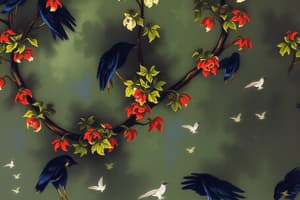Podcast
Questions and Answers
Which of the following literary forms is characterized by a long narrative poem about a hero's quests?
Which of the following literary forms is characterized by a long narrative poem about a hero's quests?
- Riddle
- Folktale
- Epic (correct)
- Fable
What is the primary purpose of a fable?
What is the primary purpose of a fable?
- To entertain with fictional stories
- To teach human values using animals as characters (correct)
- To present mind puzzles and riddles
- To explain origins of natural phenomena
Which writer is known for depicting the immorality of friars in his work 'Fray Botod'?
Which writer is known for depicting the immorality of friars in his work 'Fray Botod'?
- Marcelo H. Del Pilar
- Graciano Lopez Jaena (correct)
- Jose Rizal
- Francisco Baltazar
Which work is associated with the writer known as 'Balagtas'?
Which work is associated with the writer known as 'Balagtas'?
What type of narrative seeks to explain cultural beliefs through stories about gods and goddesses?
What type of narrative seeks to explain cultural beliefs through stories about gods and goddesses?
Flashcards are hidden until you start studying
Study Notes
Filipino Literature: Pre-Colonial Period
- Folk Songs: Lyrical expressions specific to a region.
- Examples: "Sitsiritsit" and "Bahay Kubo"
- Riddles: Mystifying questions or puzzles meant to be solved.
- Examples:
- "Isang balong malalim, punong puno ng patalim" (Answer: bibig - mouth)
- "Dalawa kong kahon, buksan walang ugong" (Answer: mata - eyes)
- Examples:
- Epics: Long narrative poems about a hero's quests with supernatural abilities.
- Example: "Biag ni Lam-ang"
Filipino Literature: Prose Narrative (Pre-Colonial Period)
- Myths: Stories about gods and goddesses used to explain mysteries, beliefs, and cultural practices.
- Fables: Stories intended to teach human values with animals as central characters exhibiting human qualities.
- Legends: Stories explaining the origins of matters.
- Folktales: Fictional stories passed down through generations of a particular group of people.
Filipino Literature: Spanish Colonial Period (1565-1898)
- Graciano Lopez Jaena:
- Wrote "Fray Botod".
- "Botod" refers to a big-bellied man and satirizes the abuse and immorality of friars.
- Editor of "La Solidaridad", a newspaper advocating for political and social reform through democratic means.
- Wrote "Fray Botod".
- Marcelo H. Del Pilar:
- Founder of "Diariong Tagalog".
- Known as the "Master of Tagalog Language".
- Joined other propagandists in 1888 and wrote pamphlets criticizing the friars' administration.
- Francisco Baltazar:
- Known as "Balagtas".
- Wrote "Florante at Laura".
- The setting of "Albanya" in the poem reflects the tyranny of the Spanish rule.
- Jose Rizal:
- Wrote the novels "Noli Me Tangere" (Touch Me Not) and "El Filibusterismo" (The Traitor).
- "Noli Me Tangere" is considered Rizal's "work of heart" while "El Filibusterismo" represents his "work of mind".
- Wrote "Mi Ultimo Adios", "Sobre La Indolencia Delos Filipinos", and "Filipinas Dentro De Cien Anos".
- Wrote the novels "Noli Me Tangere" (Touch Me Not) and "El Filibusterismo" (The Traitor).
- Andres Bonifacio:
- Father of the Katipunan.
- Wrote "Pag-ibig sa Tinubuang Lupa" (Love for the Native Land).
- Emilio Jacinto:
- Brains of the Katipunan.
- Wrote political essays in folk language.
Studying That Suits You
Use AI to generate personalized quizzes and flashcards to suit your learning preferences.




